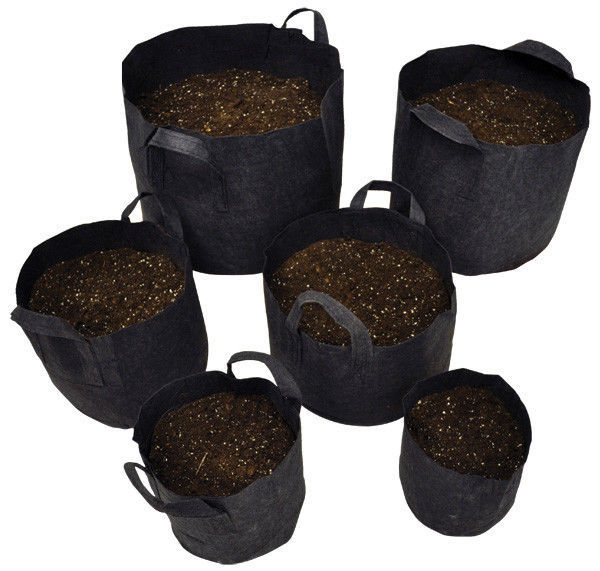I started growing my medicine using the NFT (Nutri-Film Technique) system, a form of hydroponics that’s quite easy to use and doesn’t take a lot of height. That’s quite useful when growing in tents! But now that the weather is getting warmer I’m going to try my first proper soil grow. But I’m not going to just shove seedlings into the ground, tempting though it is. I’m going to do this using ‘fabric pots,’ also called ‘smart pots’…
These are fabric containers that help the roots grow thicker and more healthily than regular solid-sided pots. In regular pots the roots that hit the sides of the plant pot just keep growing longer, circling around the pot walls, choking themselves up and not growing as much of a mass of fine, healthy root hairs. But in fabric pots, when the roots hit the sides of the container they peek through and get their tips ‘burned off’ by contact with the air. It sounds alarming, but the result is lots of smaller, finer roots growing from those ones. They also get more oxygen through the soil, which keeps the soil healthier and helps them grow faster – especially in the vegetative grow stage. This also means the root mass is kept a little cooler on hot days.
The smart pot difference? Happier, healthier plants, and better yields when it’s time to harvest. What’s not to like?
The other benefit over growing right in the ground is being able to move the plants if I need to. If someone comes over and they don’t know what I’m doing I can keep it that way by moving the plants out of sight, then bringing them back to the prime sun spot later.
I made a mistake at the start by misjudging the size of the pots. Ordering on Amazon is always easy, but not seeing the things in real life can make size estimates a bit like guesswork! My first order arrived and the fabric pots turned out to be definitely too small – I’d misread the description and mistaken litres for gallons! Never mind, they’ll be handy as containers for random stuff. My next order was 5 gallon fabric pots. They’re STILL smaller than I expected, although they’ll be fine for some quick-growing autoflowering seeds that won’t get particularly large. I’ve now ordered some 12 gallon pots for my Frisian Duck seeds. They will be here in plenty of time, and they’ll definitely be big enough. Sure, a little awkward to move, but big enough to give ample growing room.
Okay, the dense root ball that these pots make mean you can use slightly smaller pots than you’d get away with in ordinary pots. But still beware going too small and stunting your plants.

Pot size in gallons and litres:
| Gallons | Litres | My comments |
| 1 | 4.5 | Too small |
| 3 | 11 | Just about okay for plants up to ~4 feet tall |
| 5 | 19 | Okay for most plants |
| 8 | 30 | Reasonable for most |
| 12 | 45 | Good for pretty much any size (and the final size I bought) |
| 16 | 60 | Overkill except for monsters |
I got a couple of plastic air pots too for comparison. These are hard plastic structures that have walls covered with hundreds of ‘innie and outie’ shapes The solid innies stick inwards and guide roots towards the open-ended outies, where they hit the air and behave just the same as in fabric pots. Reports show these are as effective as fabric pots and can be used at slightly smaller sizes. These are easily reusable (the fabric ones are reusable but take cleaning up and will always LOOK used after one grow) but they do cost five or more times as much as fabric. If you get very hot sun the hard black plastic might get a bit too warm. We’ll see.

There is one down side to using fabric or air pots: they will need more regular watering as they can dry out a bit more easily than traditional pots. It’s not anything too extreme, but don’t forget them for a few days especially as the weather warms up: water probably every other day. On the plus side, it’s harder to overwater something growing in a smart pot or air pot. Although don’t take that as a challenge.
It’s also best not to put them directly on the ground or you may find the roots grow right through the bottom and into the earth beneath, making them impossible to move! Put the pots on a paving slab or a large plastic drip tray to catch water runoff and keep the roots in check.
Hydroponics will give you better yields, but both the fabric pots and plastic air pots will produce better and happier plants than you’ll get from traditional solid plastic or earthenware pots. These are also much lower maintenance and need much less equipment than any hydroponics setup. If you have an outside space where you can put one or more of these, do it.
Further reading
- GrowWeedEasy.com: smart pots vs air pots vs regular pots
- RoyalQueenSeeds.com: can air pots and smart pots increase cannabis yield?
- MaximumYield.com: why more growers are switching to fabric pots
One Comment Add yours